
I decided to do something a little different with the shots column for this, its sixth year (and finally imitated — we're flattered). I thought I'd go with a metric of instinct rather than analysis.
First let me introduce the overall concept for those perhaps unfamiliar. Every year I recap the year in my own unique way. Film is, after all, about the image first, and so what better way to put 12 cinematic months in a time capsule than to feature the most striking single images of the year? But what is striking to one is always not so much to the next. Like all of this, it's in the eye of the beholder.
For my part I would always try to give my perspective on shots that might seem, well, unexpected to others. I would posit that an Eric Gautier shot of an eagle picking away at a carcass in “Into the Wild” says something about a country weighing on the soul; or that an unassuming Anthony Dod Mantle shot crammed into a frenetic “Slumdog Millionaire” montage better sums up character motivations than any other frame; or that the simplicity of Anna Kendrick riding slowly away on an airport people-mover as seen through Eric Steelberg's lens in “Up in the Air” speaks elegant volumes.
Of course, room for sheer aesthetic beauty has often been made. A devastatingly gorgeous Luc Montpellier capture of Patricia Clarkson in “Cairo Time,” for instance, or an iconic Wally Pfister distillation of The Dark Knight in, well, “The Dark Knight.” I've even argued for a Ben Seresin angle on Megan Fox against a glass bottle wall in “Transformers: Revenge of the Fallen.”
Then there are the stunts that dazzle. Jason Bourne leaping from window to shattering window in “The Bourne Ultimatum” had a hand in inspiring this annual column, while complex takes from “Let the Right One In,” “The Secret in Their Eyes” and “The Adventures of Tintin” have stood out in respective years.
And now, our sixth year. As I said, I decided to try something a little different this year. Typically I would set aside a frame of time to specifically look back at many films and note the imagery. A revisit purely for this column's purposes. This year, both so I could get the piece out sooner than usual (oh how hungry you can be — though that didn't end up happening, anyway) and so I could simply shake up the way I build it, I shot from the hip and went with the gut.
I always keep a bit of an eye out on first viewings, almost subconsciously, for potential contenders for this piece. But this time I let those stick sooner than usual. I let whatever struck me first survive, and when I had 10, that was it. Along the way this included inevitable revisits, which mostly just strengthened the original take anyway, but the point was I wondered what a first blush would look like rather than a (perhaps over-)analyzed take.
This is what I came up with…
#10
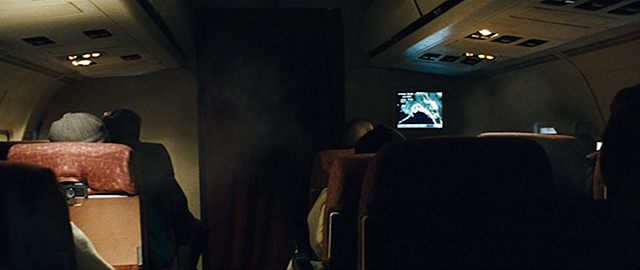
“THE GREY”
Director of Photography: Masanobu Takayanagi
“I remember it was a very tiny space to shoot. We shot on the section of the plane that the art department had cut and placed. We didn't really fake the spacing of the seating or anything. It's the real aisle space. And Joe had this idea of going through the fuselage and we start seeing the breath of the people. Not to make a big statement but just we'd see the breath and then land on Liam [Neeson]. The crew came up with a great little dolly that I was sitting on, much skinnier than a normal dolly. It was really done in a quick, elementary way. We had the plane beforehand in the prep stage and we went up there with my crew and decided to do that shot.”
– Masanobu Takayanagi
My favorite film of the year was shot by one of the great up-and-coming (though really, he's already arrived as far as the industry is concerned) DPs in the game: Masanobu Takayanagi. And “The Grey” is a film highly dependent on its imagery as it's very much a film about setting tone and atmosphere. One shot did that simply but effectively early on and always stuck with me as something worth bringing up when this column rolled around.
With the film's ensemble aboard a late-night flight over Alaska, the shot begins on a fizzling monitor before tracking back down the aisle. As it goes, the frosty breath of the passengers comes into focus, eerie, raising plenty of questions. We fall on star Liam Neeson, fast asleep, before a violent shake snaps him out of it and answers all: this bunch is in for a bumpy ride. It's a quiet, delicate little moment and it gets such a visceral reaction.
#9
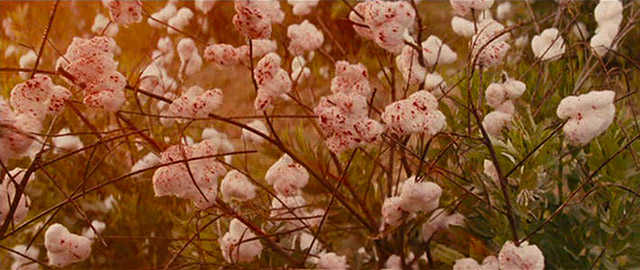
“DJANGO UNCHAINED”
Director of Photography: Robert Richardson
“I believe the image speaks magnificently to Quentin [Taranitno]'s perspective on slavery as well as a portrait of what style 'Django Unchained' is about to release. Jackson Pollock immediately surfaces to my mind, but Jackson Pollock magnified through a visceral if not near-pornographic eye. It's less abstract but equally expressionistic. And it's interesting if you compare it with the final explosion of Candie's mansion; the explosion might be seen to represent the collapse or comedown of false idols and the cotton emblematic of the first shot fired towards that demise.”
– Robert Richardson
Robert Richardson has become a staple of this list each year, and while recent entries have come for Martin Scorsese efforts, this year he pops up for Quentin Tarantino's latest, “Django Unchained.” The film is a design showcase on a number of fronts, not just photography, but Richardson, as ever, gives Tarantino's work a certain visual flare that has grown into the filmmaker's new aesthetic.
The shot I chose is full of overt thematic subtext, a spray of red blood across a crop of white cotton plants. I couldn't really put it any better than Richardson does in the quote above, but to reiterate, it goes hand in hand with the blatant revisionism of the film and its current of stylized, cathartic vengeance and, indeed, violence. The visual contrast is obviously striking but what's lurking in between the lines is what makes it so righteous and powerful.
#8
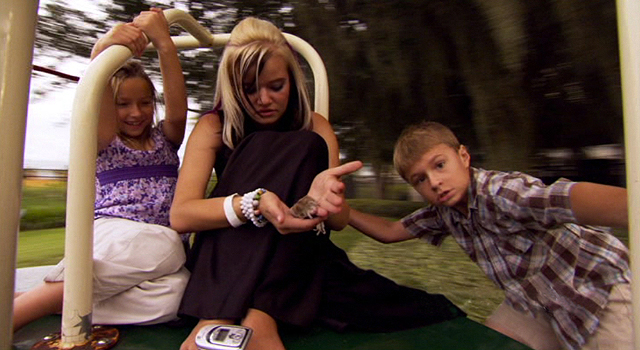
“THE QUEEN OF VERSAILLES”
Director of Photography: Tom Hurwitz
“The hard and unforgiving truth about documentary photography is that the odds are against anything really good happening twice. So we must get it the first time. If it does happen twice, we should be filming it both times, with different frames. Sometimes this means taking risks or pushing limits. It can take a career to learn when to push and when to step back. In a combat situation, one”s life can be in the balance. In less lethal environments, one”s ability to continue filming may be at risk.”
– Tom Hurwitz, IndieWire*
Lauren Greenfield's “The Queen of Versailles” wasn't just the leader of the pack in a long line of great documentaries this year, in my opinion. It was also one of the very best films of the year, period. I reacted so strongly to it because, however unexpectedly, it ended up being a powerful thematic piece of work and so crisply dialed into a time and place in this country. And one shot from the film in particular always struck me as perfectly emblematic of that.
It's a simple shot. Not much fuss to it. A seemingly mundane instance. The son of the film's subject, Jacqueline Siegel, pushes a merry-go-round round and round until finally tripping up and falling face first into the dirt. There was something so potent about it, this idea of “keeping up with the Joneses” and a shifting values landscape in the film, leading to a great fall. And all of that is right here in this unassuming real-life moment. I unfortunately couldn't get DP Tom Hurwitz on the phone to discuss but his quote above about capturing a moment when it happens seemed applicable.
#7
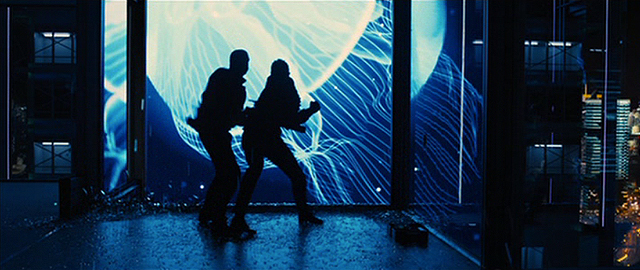
“SKYFALL”
Director of Photography: Roger Deakins
“We wanted it to feel a lot more kind of mysterious and controlled. So everything”s on a dolly, and they”re all kind of constructed shots as we developed the scene. Sam [Mendes] said, 'Well, why don”t we just play this? I don”t want to do it all in a lot of cuts because we”re doing enough of that. It would be just much more interesting.' And because we had this big screen with a jellyfish on it, just the idea of these silhouettes playing against this huge jellyfish, it”s just such an interesting sort of idea just to play it in one [shot]. Each little sequence had a slightly different feel to it.”
– Roger Deakins
Like Richardson, Roger Deakins has also become a staple of the list, and it's understandable why. He is, if not the greatest working cinematographer, then certainly on the top tier. And it's been a joy to hop on the phone with him each season to discuss what went into whatever stunning image might have tickled my fancy. This year, Deakins was responsible for perhaps the best digital photography we've seen in a feature yet, for Sam Mendes's James Bond effort “Skyfall,” and three sequences in particular, set in Shanghai, Macau and the Scottish Highlands, made for eye-popping imagery to say the least.
The shot I chose came during the Shanghai portion, which as a sequence is enveloping and awe-inspiring with its neon flourishes against the blackest of night. It's a single take of an action beat, fists and kicks flying as 007 dukes it out in a high rise with a baddie against a bright blue moving jellyfish marquee of light. Finally the camera moves in on the commotion as the antagonist is sent flying out the window. It's not the most thematically dense image I've chosen from Deakins over the years, but there was a majesty to it nevertheless.
#6
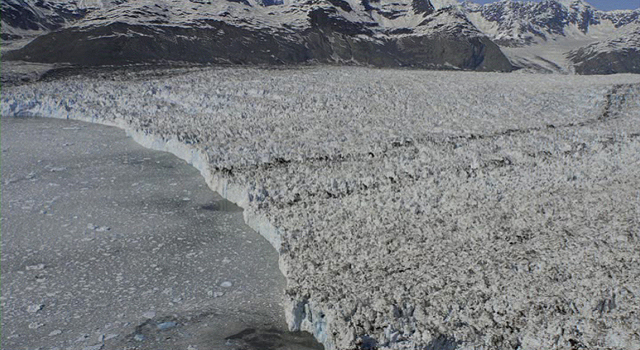
“CHASING ICE”
Director of Photography: Jeff Orlowsky
“That camera was called AK-3. It was the third camera that was installed in Alaska. I was involved on maintenance on that camera but James [Balog] was the one who actually installed that camera. We certainly weren't expecting that [amount of movement] at all. Fortunately the camera was in a place where we could pan it a while. Since then, that camera has actually physically been moved to another location because the glacier retreated so far out of frame that it was pretty much inaccessible to capture from that spot. We weren't expecting the glaciers to change as much as they were, but this was far more dramatic.”
– Jeff Orlowsky
One of the great feats of photography this year was unquestionably Jeff Orlowsky's “Chasing Ice.” Part profile of photographer James Balog and his mission to capture the world's receding glaciers on film, part eye-opening document about climate change, the film had more than its fair share of staggering images. But one in particular was the film's money shot, and it may be a bit of a cheat to include it on here, but when you get down to it, it's actually the essence of cinema.
The shot is a time-lapse depiction of the Columbia Glacier in Alaska receding on an epic scale. In fact, as the context of the film reveals, they had to keep going back and panning the camera to capture the full extent. So this shot is really a series of single frames, shown at a key moment toward the end of the film in a keynote setting. But then again, no cinema “shot” isn't a series of single frames. So it's fair. And in a great year for documentaries, two showing up on this countdown already, none had a moment on camera quite like this.
Continue to part two and the top five shots of the year!
*Tom Hurwitz was unavailable for original comment.
***


 Archives
Archives